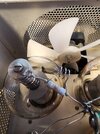I just bought an SB220, which squeals on AM 10 and 11 Meters. It has the Harbach Electronics SK-220 Soft-Key Keying Interface and Replacement Filter Capacitor Block.
SSB is nice and clear both 11 and 10 meters.
110v
Does anyone know what it could be?
SSB is nice and clear both 11 and 10 meters.
110v
Does anyone know what it could be?

